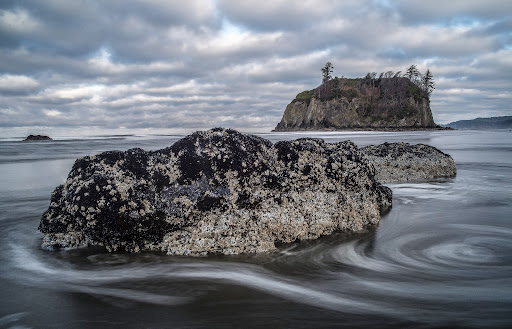The Power of Focus
It’s the time of year when you’re preparing next year’s plan, I hope. As you move farther up the Ramp, though, the risk of losing focus grows.
Why?
Well, now you have the cash to entertain all manner of distractions you quickly ignored early on: adding lots of new UPCs, extending into new categories, paid marketing in dozens of forms, national sampling programs, paid endcaps and displays, and the list goes on.
Here’s an excerpt from one of my most popular white papers (from before the book!)
“Inspiration for this shot [see above] came after 45 minutes of pacing up and down the windswept beach during the pre-dawn hours in what looked like a ski outfit (it was cold folks). As I scanned all around me and absorbed the coastal geometry, I noticed swirling sea foam eddies next to a large, barnacle-coated rock. What if I could capture what it felt like to be a rock experiencing this tidal action?
To pull this off, I needed a wide-angle shot, very close to my subject rock. But I wanted everything in focus to enhance the drama. Then, I had to slow down the exposure to capture the swirling sea foam, like paint on a canvas. I had to do all of this while standing in two feet of seawater, with three neutral density filters that prevented me from seeing through the viewfinder once they were inserted. So, I carefully adjusted my focus ring in tiny increments until test shots yielded ‘hyper-focus- sharp focus from foreground to background. On my nano-coated 28 mm f4 prime lens, this was literally a matter of a few millimeters on the focal ring. Then, I had to take shot after shot until I found one where the tripod hadn’t moved due to shifting sands caused by the tidal surges every 30-60 seconds. Yes, the same tidal forces creating the beautiful swirling in my photo also threatened to move my tripod and destroy my foreground focus. The exposures needed to last about 5 seconds to capture the motion. That was five full seconds where the slightest movement of the tripod would destroy the image. As I was getting lucky, the sun peaked above the forest behind me, casting light on my filters. This backlighting reflected off the filter and cast a nasty red flare on about five shots before I noticed it. My left hand now went up to block the backlight. I was punished for being cheap and not buying a $300 screw-mount, professional, multi-stop ND filter. Good grief. Amateur hour.
After about 85 shots, including the initial test shots for focus, I had this one and a couple of other professional-grade images. I trust most of you are not photography geeks. So, you probably didn’t follow all the details of my story. Good. Then, you can appreciate my point even better from outside the fishbowl of your daily entrepreneurial activity.
By committing 110% to a specific image concept, I focused on all the myriad other technical issues necessary to capture it. Because, if I hadn’t, I would have walked away from that beach with a whole bunch of cute point-and-shoot images anyone could have taken.
The complexity of the above shoot is your allegory for the complexity of managing a holistic, professional go-to-market strategy in premium food and beverage, a world that is ever more competitive with each passing year. It used to be the case that you could have a mediocre tasting, natural product, and if you could find the right broker and production funding, sail right to $10M and beyond.
No more.
Focus yields enhanced precision, enhanced control over complex outcomes.”
Read more in this classic issue of PGS Monthly, a monthly white-paper series of in-depth content for today’s most ambitious CPG founders intent on scaling their brands. If you’d like access, take my Founder’s Quiz, and you’ll get signed up for special semi-monthly e-mails. Sign-ups are screened.
